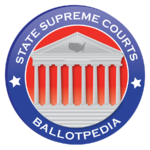Judicial selection in North Dakota
| Judicial selection in North Dakota | |
 | |
| North Dakota Supreme Court | |
| Method: | Nonpartisan election |
| Term: | 10 years |
| North Dakota Court of Appeals | |
| Method: | Court appointment |
| Term: | Up to 1 year |
| North Dakota District Courts | |
| Method: | Nonpartisan election |
| Term: | 6 years |
Judicial selection refers to the process used to select judges for courts. At the state level, methods of judicial selection vary substantially in the United States, and in some cases between different court types within a state. There are six primary types of judicial selection: partisan and nonpartisan elections, the Michigan method, assisted appointment, gubernatorial appointment, and legislative elections. To read more about how these selection methods are used across the country, click here.
This article covers how state court judges are selected in North Dakota, including:
- North Dakota Supreme Court,
- North Dakota Court of Appeals,
- North Dakota District Courts, and
- Limited jurisdiction courts
As of April 2023, judges for all courts in the state of North Dakota, except the North Dakota Court of Appeals, were selected through nonpartisan elections.[1] The court of appeals had no permanent judges; the judges were named to the court by the supreme court. Judges' terms began on January 1 following their election.[2]
Click here to notify us of changes to judicial selection methods in this state.
North Dakota Supreme Court
- See also: North Dakota Supreme Court
The five justices of the North Dakota Supreme Court are chosen in nonpartisan elections. Judicial candidates compete in a primary election, and the top two candidates advance to the general election in November.[3] If a justice retires or dies in office, the governor may appoint a justice to the court for two years, when the appointed justice must then run in a nonpartisan election.[4]
Once elected, judges serve 10-year terms. At the expiration of a judge's term, he or she must run for re-election to remain on the court.[3]
Qualifications
To serve on this court, a judge must be:
- a U.S. and state citizen and
- a licensed attorney.[3]
Chief justice
The court's chief justice is chosen by a vote of the supreme and district court judges to serve a five-year term.[3]
Vacancies
In the event of a midterm vacancy, the governor appoints a replacement with help from a judicial nominating commission. Alternatively, the governor may call a special election to fill the vacancy. Appointed judges are to serve for at least two years, after which they must run in the general election to finish the remainder of the unexpired term.[5] If a justice retires or dies in office, the governor may appoint a justice to the court for two years, when the appointed justice must then run in a nonpartisan election.[6] The map below highlights how vacancies are filled in state supreme courts across the country.
See also
External links
Footnotes
- ↑ 1.0 1.1 1.2 1.3 1.4 1.5 National Center for State Courts, "Methods of Judicial Selection: North Dakota," accessed August 16, 2021
- ↑ North Dakota Secretary of State, "Qualifications and Terms of Office for all Elected Positions in North Dakota," accessed August 16, 2021
- ↑ 3.0 3.1 3.2 3.3 National Center for State Courts, "Methods of Judicial Selection: North Dakota," accessed August 16, 2021
- ↑ State of North Dakota, "Supreme Court," accessed September 8, 2022
- ↑ National Center for State Courts, "Methods of Judicial Selection: North Dakota," accessed August 16, 2021
- ↑ State of North Dakota, "Supreme Court," accessed September 8, 2022
- ↑ 7.0 7.1 The North Dakota Judicial System, "The Structure of the Judicial System," accessed August 20, 2014
- ↑ National Center for State Courts, "Methods of Judicial Selection: North Dakota," accessed October 20, 2015
- ↑ National Center for State Courts, "Methods of Judicial Selection: North Dakota," accessed August 16, 2021
- ↑ 10.0 10.1 National Center for State Courts, "Methods of Judicial Selection: North Dakota," accessed August 16, 2021
- ↑ National Center for State Courts, "History of Reform Efforts: North Dakota," accessed August 17, 2021
- ↑ U.S. Courts, "FAQ: Federal Judges," accessed March 26, 2015
- ↑ American Bar Association, "Judicial Selection: The Process of Choosing Judges," accessed August 10, 2021
Federal courts:
Eighth Circuit Court of Appeals • U.S. District Court: District of North Dakota • U.S. Bankruptcy Court: District of North Dakota
State courts:
North Dakota Supreme Court • North Dakota Court of Appeals • North Dakota District Courts • North Dakota Municipal Courts
State resources:
Courts in North Dakota • North Dakota judicial elections • Judicial selection in North Dakota


